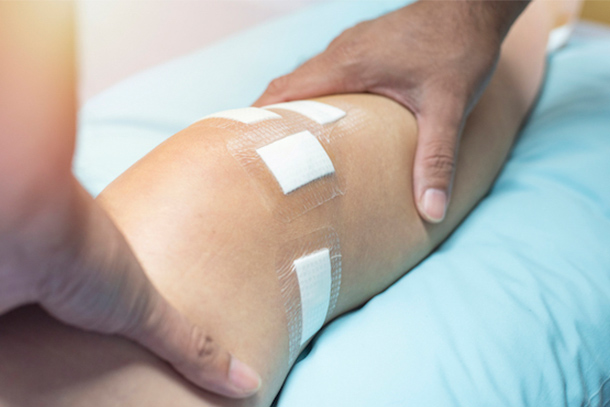
A patient receives a check-up after reconstructive ACL surgery. IMAGE: ISTOCK
Grant recipients work to improve reconstructive ACL surgeries
9/16/2019
By Jamie Oberdick
UNIVERSITY PARK, Pa. — Spencer Szczesny, assistant professor of biomedical engineering, and Aman Dhawan, sports medicine orthopedic surgeon and associate professor with the Penn State College of Medicine, have been awarded one of two annual Grace Woodward Grants for Collaborative Research in Engineering and Medicine.
The pair was awarded $50,000 to study patient rehabilitation and recovery after reconstructive surgery for tears of the anterior cruciate ligament (ACL). The ACL, located within the knee, is essential for stable joint motion and is most commonly repaired through surgery. According to the American Academy of Orthopedic Surgeons, between 100,000 and 200,000 Americans experience ACL tears on average every year. About 70% of all ACL reconstructive surgeries are in active individuals aged 35 and under, as the injury can frequently result from sporting accidents, such as skiing.
The reconstructive surgery involves anchoring a tendon graft in the same location in the knee as the original ligament.
“A common issue in these reconstructions is that young, active individuals continue to produce increased mechanical forces in their knees,” Szczesny said. “As a result, the type of graft we use plays an important role in how they recover, and our study is looking at potential solutions for a fairly serious issue with one particular type of graft.”
The graft in ACL reconstructive surgery is either an autograft, which is a ligament taken from another part of the patient’s body, or an allograft, which is a ligament from a cadaver. While allografts cause less pain and fewer post-surgery complications, such as decreased range of motion and muscle weakness, they also fail three to four times more often than autograft reconstructions.
According to Szczesny, previous research suggests that the issue with allografts is how they adapt over time in the knee. Both types of grafts have similar mechanical properties immediately after surgery. Soon after reconstruction, the patient’s cells invade the graft tissue and begin to change the tendon’s structure into something that more closely resembles the ACL.
This causes a temporary weakness in the graft, but the graft mechanics slowly recover — they recover better in the autograft than in the allograft.
“Dr. Dhawan and I are testing this novel hypothesis,” Szczesny said. “We think the reason for the impaired performance of the allograft reconstructions is that they are more sensitive than autografts to use in young knees.”
Szczesny and Dhawan’s objective is to determine whether allografts respond differently on a cellular level to mechanical forces than autografts and whether this contributes to the post-surgery allograft failures.
“Our study evaluates what is happening mechanically and biologically at the cellular level and in real time,” Dhawan said. “Models of these allografts and autografts help us accurately identify the cause of this increased failure rate.”
The researchers measure the number of genes that graft cells express during the mechanical forcing. By measuring both the strain in the graft cells and the genes the cells express, they’re working to identify whether allografts have a different response to the mechanical stimuli than autografts. They’re also applying mechanical forcing to the grafts over time to determine whether the cells change behavior in response to the mechanical force, which could lead to stiffness in a human patient.
The results of their research could lead to optimized patient rehabilitation protocols that enable proper allograft strengthening after reconstructive ACL surgery, according to Szczesny. In addition, the testing model they develop may be used to test new drug treatments that would aid in patient recovery after these surgeries.
“This study represents an exciting collaboration between bioengineers at the College of Engineering and academic surgeons at the College of Medicine to tackle a real-life common clinical challenge,” Dhawan said. “This research will go a long way to help us fundamentally understand graft biology and mechanics, changing the way we view and perform ACL surgery in the future.”
Preliminary work on the project began earlier this year and is planned to continue throughout the two-year project period.
The Grace Woodward Grants for Collaborative Research in Engineering and Medicine are given annually by the Penn State Colleges of Engineering and Medicine. They are made possible by the support of endowments from the estate of Grace Woodward, a longtime friend and supporter of the University. The program is designed to encourage genuine collaborations between engineers and clinicians or biomedical scientists that involve either new avenues of research or the feasibility testing of new medical devices, instrumentation or other diagnostic or therapeutic modalities.

